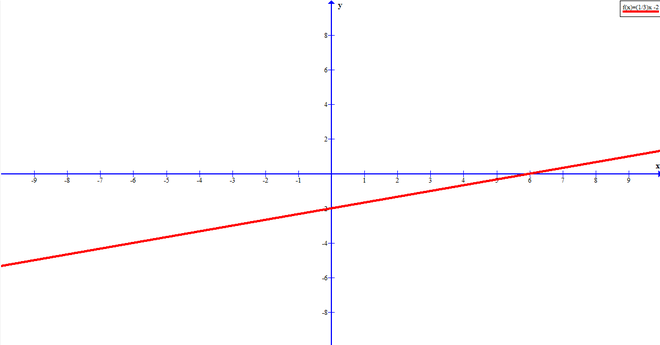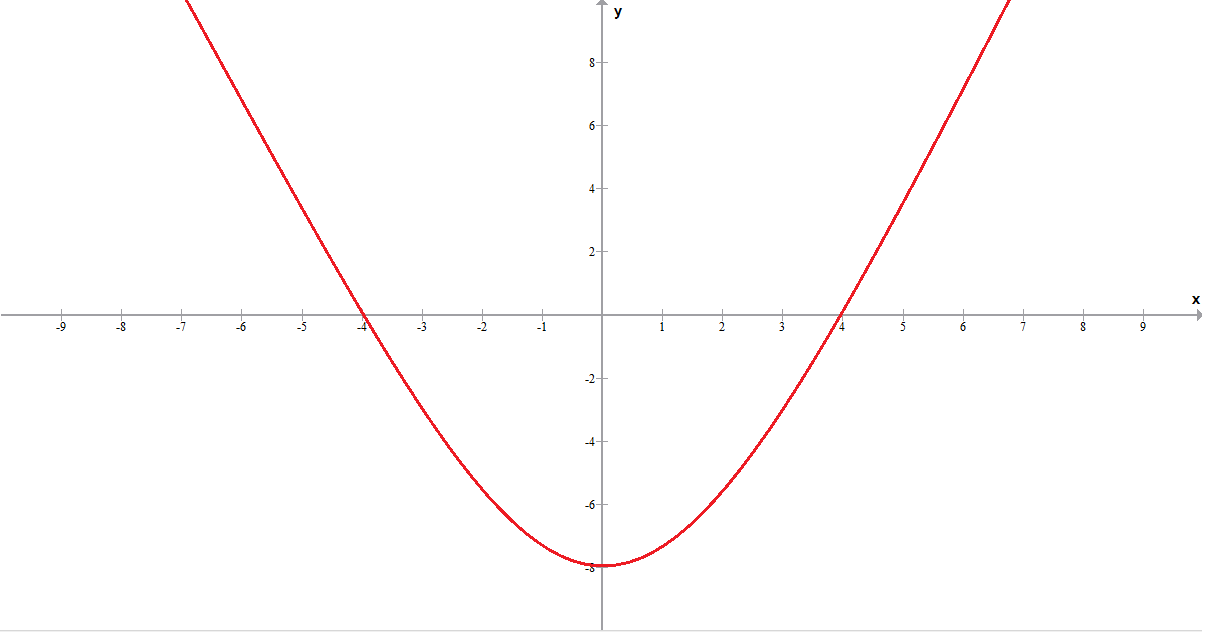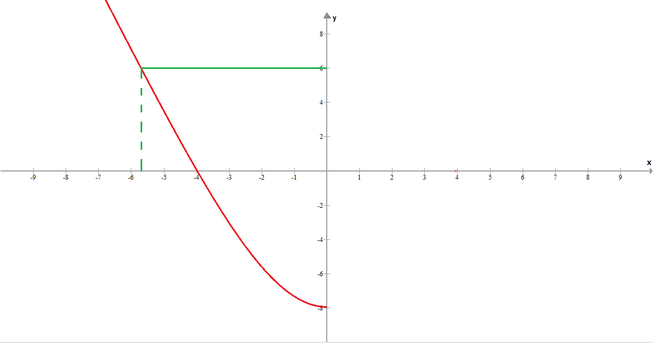顾名思义可逆手段“逆“,可逆函数意味着函数的逆。从最一般的意义上讲,逆函数是彼此“逆向”的函数。例如,如果f将a取到b,则逆数f -1必须将b取到a。

The inverse of a function is denoted by f-1
换句话说,我们可以定义,如果f是一个设定的通过交换在f各自的有序对的第一和第二坐标获得有序对被称为f的反函数。让我们借助一个示例来理解这一点。
例子:
function g = {(0, 1), (1, 2), (2,1)}, here we have to find the g-1
As we know that g-1 is formed by interchanging X and Y co-ordinates.
g = {(0, 1), (1, 2), (2, 1)} -> interchange X and Y, we get
g-1 = {(1, 0), (2, 1), (1, 2)}
So this is the inverse of function g.
逆函数
我们可以通过在图表上作图来检查函数是否可逆。我们可以通过给定函数绘制的图形,并检查该函数的可逆性,函数是否可逆与否。让我们为函数绘制图形,并检查f(x)= 3x + 6是否可逆。该函数具有截距6和斜率3。让我们为函数绘制图形

例子:
让我们找出给定函数的逆函数。
f(x) = 3x + 6
Interchange x with y
x = 3y + 6
x – 6 = 3y
y = (x – 6) / 3
y = (1 / 3)x / 3
f-1(x) = (1 / 3) x / 3
现在让我们绘制f -1 (x)的图。具有截距和斜率分别为3和1/3的函数的逆函数。

函数及其逆函数将围绕y = x对称。然后,该函数被认为是可逆的。因此,让我们绘制函数的两个函数和反相之间的界线,并检查是否对称或不分开。

画出直线y = x后,我们观察到直线对称地与两个函数的直线相交。因此,函数f(x)是一个可逆函数,通过这种方式,我们可以绘制一个逆函数并检查可逆性。
函数可逆的条件
Condition: To prove the function to be invertible, we need to prove that, the function is both One to One and Onto, i.e, Bijective.
解释
我们可以说,当域的每个元素在映射后具有共域的单个图像时,该函数是一对一的。我们可以说,函数是走上当函数的范围应该等于陪域。当我们证明给定函数既是一对一又是Onto时,我们可以说给定函数是可逆的。让我们看一些例子,以正确了解情况。
示例1:让A:R – {3}和B:R – {1}。考虑函数f:由f(x)=(x – 2)/(x – 3)定义的A->B。证明函数f(x)是可逆的,因此找到f -1 。
Solution:
To show the function is invertible, we have to verify the condition of the function to be invertible as we discuss above. To show that the function is invertible we have to check first that the function is One to One or not so let’s check.
Let x, y ∈ A such that f(x) = f(y)
=> (x – 2) / (x – 3) = (y – 2) / (y – 3)
=> (x – 2) (y – 3) = (x – 3) (y – 2)
=> xy – 3y – 2y + 6 = xy – 2x – 3y + 6
=> -3x + 2y + 6 = xy – 2x – 3y + 6
=> -3x + 2x = -3 + 2y
=> -x = -y
=> x = y
Since f(x) = f(y) => x = y, ∀x, y ∈ A, so function is One to One.
We have proved the function to be One to One. Now let’s check for Onto. To show that f(x) is onto, we show that range of f(x) = its codomain.
Let y = (x – 2) / (x – 3)
Put f(x) = y.
=> xy – 3y = x – 2
=> xy – x = 3y – 2
=> x(y – 1) = 3y – 2
=> x = (3y – 2) / (y -1) —-(1)
Since x ∈ R – {3}, ∀y R – {1}, so range of f is given as = R – {1}. Also codomain of f = R – {1}.
Therefore, Range = Codomain => f is Onto function
As both conditions are satisfied function is both One to One and Onto, Hence function f(x) is Invertible. Now as the question asked after proving function Invertible we have to find f-1
from eq(1) we get,
f-1(y) = (3y – 2) / (y – 1)
=> f-1(x) = (3x – 2) / (y – 1)
示例2:表明f:由f(x)= 3 / x给出的R – {0}-> R – {0}是可逆的。
Solution:
To show the function f(x) = 3 / x is invertible.
We have to check first whether the function is One to One or not.
Let x1, x2 ∈ R – {0}, such that f(x1) = f(x2). Then,
f(x1) = f(x2)
=> 3 / x1 = 3 / x2
=> x1 = x2
Thus, f(x1) = f(x2)
=> x1 =x2 ∀x, y ∈ R – {0}
So, function f is One to One.
We have proved that the function is One to One, now le’s check whether the function is Onto or not.
Let y be an arbitary element of R – {0}.
Then for y in the codomain R – {0},
there exist its pre-image in the domain R – {0}. So f is Onto.
Since we proved the function both One to One and Onto, the function is Invertible.
示例3:考虑f:由f(x)= x 2 + 4给出的R + -> [4,∞]。证明f是可逆的,其中R +是所有非负实数的集合。
Solution:
To show that the function is invertible or not we have to prove that the function is both One to One and Onto i.e, Bijective
Let’s check for One to One.
Here function f: R+ -> [4, infinity)
Given by f(x) = x2 + 4,
Let x, y ∈ R+, such that f(x) = f(y)
=> x2 + 4 = y2 + 4
=> x2 = y2
=> x = y [Since we have to take only +ve sign as x, y ∈ R+]
Therefore, f is One to One function.
Now, we have to check for Onto.
For y ∈ [4, infinity), let y = x2 + 4
=> x2 = y – 4 ≥ 0
=> x = √(y – 4) ≥ 0 [we take only +ve sign, as x ∈ R+]
Therefore, for any y ∈ R+ (codomain), there exists
x = √(y – 4) R+ (domain) such that
f(x) = f(√(y-4)) = (√(y – 4))2 + 4 = y – 4 + 4 = y
Therefore, f is Onto function.
Since function f(x) is both One to One and Onto, function f(x) is Invertible.
确定函数是否可逆
正如我们上面讨论的,函数可逆的条件,我们将检查确定函数是否可逆的相同条件。因此,让我们考虑一些问题以正确理解如何确定函数是否可逆。
示例1:如果 f是一个可逆函数,定义为f(x)=(3x -4)/ 5,然后写f -1 (x)。
Solution:
In the question given that f(x) = (3x – 4) / 5 is an invertible and we have to find the inverse of x. So, firstly we have to convert the equation in the terms of x. In the below figure, the last line we have found out the inverse of x and y. So, this is our required answer.
Given, f(x) (3x – 4) / 5 is an invertible function.
Let, y = (3x – 5) / 5
5y = 3x – 4
3x = 5y + 4
x = (5y – 4) / 3
Therefore, f-1(y) = (5y – 4) / 3 or f-1(x) = (5x – 4) / 3
示例2:f:R->由f(x)= 2x -1定义的R,找到f -1 (x)?
Solution:
As we done in the above question, the same we have to do in this question too. In the question we know that the function f(x) = 2x – 1 is invertible. Let us have y = 2x – 1, then to find its inverse only we have to interchange the variables.
Given,
f(x) = 2x -1 = y is an invertible function.
Let, y = 2x – 1
Inverse: x = 2y – 1
therefore, f-1(x) = (x + 1) / 2
示例3:证明定义为f(x)= 4x – 7的函数f:R-> R是not的可逆的,也找到f -1 。
Solution:
In the question, given the f: R -> R function f(x) = 4x – 7. We have to check if the function is invertible or not. So, to check whether the function is invertible or not, we have to follow the condition in the above article we have discussed the condition for the function to be invertible. So as we learned from the above conditions that if our function is both One to One and Onto then the function is invertible and if it is not, then our function is not invertible. So, let’s solve the problem firstly we are checking in the below figure that the function is One-One or not.
One-One function means that every element of the domain have only one image in its codomain. So we had a check for One-One in the below figure and we found that our function is One-One. Now, the next step we have to take is, check whether the function is Onto or not. The function is Onto only when the Codomain of the function is equal to the Range of the function means all the elements in the codomain should be mapped with one element of the domain. So, we had checked the function is Onto or not in the below figure and we had found that our function is Onto. So, the condition of the function to be invertible is satisfied means our function is both One-One Onto. Hence we can prove that our function is invertible.
Given, f : R -> R such that f(x) = 4x – 7
For one to one:
Let x1 and x2 be any elements of R such that f(x1) = f(x2), Then
f(x1) = f(x2)
4x1 – 7 = 4x2 – 7
4x1 = 4x2
x1 = x2
So, f is one to one
For onto:
Let y = f(x), y belongs to R. Then,
y = 4x – 7
x = (y+7) / 4
From above it is seen that for every value of y, there exist it’s pre-image x.
So, f is onto
Thus, f is being One to One Onto, it is invertible.
反三角函数
反函数有很多类型,如函数,逆日志功能,反有理函数的,反理性的功能,等等。在下面的表中有一个与他们的定义域和值域反三角函数的列表。
|
Inverse Trigonometric Function |
Domain |
Range |
|---|---|---|
|
sin-1(x) |
[-1, 1] |
[-pie / 2 , pie / 2] |
|
cos-1(x) |
[-1, 1] |
[0 , pie] |
|
tan-1(x) |
R |
(-pie / 2 , pie / 2) |
|
sec-1(x) |
R – (-1, 1) |
[0, pie] – {pie / 2} |
|
cosec-1(x) |
R – (-1, 1) |
[ – pie / 2, pie / 2] – {0} |
|
cot-1(x) |
R |
(0, pie) |
使用代数查找反函数
示例1:找到函数f(x)=(x + 1)/(2x – 1)的逆,其中x≠1/2
Solution:
For finding the inverse function we have to apply very simple process, we just put the function in equals to y.
(x+1) / (2x-1) = y
x +1 = 2xy – y
x- 2xy = -y – 1
x(1- 2y) = -y – 1
x = (-y – 1) / (1 – 2y)
By taking negative sign common, we can write ,
x = (1 + y) / (2y – 1)
f-1(x) = (1 + x / (2x – 1)
This is the required inverse of the function.
示例2:求解:f(x)= 2x /(x -1)
Solution:
As we done above, put the function equal to y, we get
2x / (x – 1) = y
2x = xy – y
2x – xy = -y
Taking x common from the left hand side
x (2 – y) = -y
x = -y / (2 – y)
Taking y common from the denominator we get,
x = y / (y – 2)
f-1(x) = x / (x – 2)
This is required inverse of the function.
例3:找到函数f(x)= 2x 2 – 7x + 8的逆函数
Solution:
We follow the same procedure for solving this problem too,
put the function equal to y, we get
2x2 – 7x + 8 = y
Taking 2 common from left hand side
2 [ x2 – (7 / 2)x + 4] = y
To make the perfect square of (x – y)2 ,
we have to divide and multiply by 2 with second term of the expression.
Adding and subtracting 49 / 16 after second term of the expression.
We get,
2[ x2 – 2. (7 / 2*2). x + 49 / 16 – 49 / 16 +4] = y
See carefully the underlined portion, it is the formula (x – y)2 = x2 – 2xy + y2
We can write this,
2(x – (7 / 4))2 – 49 / 8 + 8 = y
2(x – (7 / 4))2 = y – (15 / 8)
(x – (7 / 4))2 = (y / 2) – (15 / 8)
Now, remove square root,
x – (7 / 4) = square-root((y / 2) – (15 / 32))
x = (7 / 4) + square-root((y / 2) – (15 / 32))
f-1(x) = (7 / 4) + square-root((x / 2) – (15 / 32))
This is the required inverse of the function.
限制功能域以使其可逆
如上述标题所示,要使函数不是可逆函数可逆,我们必须限制或设置函数应成为可逆函数。我们知道函数是采用一组数字的东西,并将这些数字中的每个数字映射到另一组数字。因此,如果我们从一组数字开始。

| x | f(x) |
|---|---|
| 0 | -8 |
| 2 | -6 |
| -2 | -6 |
上表显示我们在域中尝试不同的值,并通过查看图表来了解f(x)值。当x = 0时,我们的图形告诉我们f(x)的值为-8,对于2和-2而言,我们分别得到-6和-6。正如我们在上表中看到的给定2和-2的结果,我们得到了输出-6,对于该函数来说是可以的,但它不应是可逆函数。那么,在图中定义的函数是不可逆的,为什么它不应该是不可逆的呢?因为如上表所示,x的两个值映射了f(x)的单个值。为了使该函数可逆,您应该找到一个映射其他函数,这意味着您可以找到该函数的逆函数,因此让我们来看一下
| y = f(x) | x = f-1(y) |
|---|---|
| -8 | 0 |
| -6 | 2 or -2? |
因此,如果我们找到反函数,并且给定-8的反函数为0,那应该没问题,但是当我们给出-6时,我们发现有趣的东西就是2或-2,这意味着该函数不再是可逆的,如下图所示。

同样,如果我们检查4,我们将得到两个x值,如上图所示。现在,我们必须限制域,以便我们的函数如何变为可逆的。因此,我们可以通过两种方式限制域
- (0,∞)
- (-∞,0)
Le的第一种尝试方法,如果我们将域从0限制为无穷大,那么我们将得到如下图

我们有这个图,现在当我们检查图上是否有y的值时,我们得到一个x的值,以同样的方式,如果我们检查y的任何正整数,我们将只得到x的一个值。现在,让我们尝试第二种方法,其中将域从-infinity限制为0。如果绘制图形,则图形如下所示。

在此图中,我们正在检查y = 6,是否获得了x的单个值。现在,如果我们检查y的任何值,我们将得到x的单个值。因此,在我们的两种方法中,我们的图形都给出一个值,这使其可逆。因此,我们使函数可逆的受限域是
- (0,∞)
- (-∞,0)